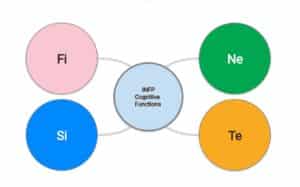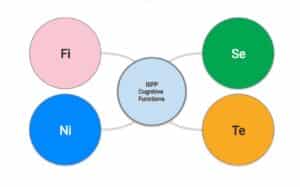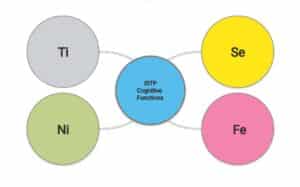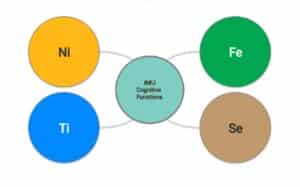Reading Time: 18 Minutes
So, you’ve probably heard of INTPs—the curious, puzzle-solving types who always seem to be deep in thought. But what really goes on in that head of theirs? It all boils down to something called INTP Cognitive Functions. These are the mental tools that shape how INTPs think, feel, and interact with the world. By understanding these functions, you’ll get a clearer picture of what makes INTPs tick, and maybe even learn a bit about yourself if you happen to be one of them.
Overview of the Four Primary Cognitive Functions Of INTP
The INTP’s brain operates with four main players, called cognitive functions. These functions are like a stack of cards, each with its own importance. The stack starts with the most powerful function and goes down to the least developed one. Each function has its strengths and weaknesses, shaping how an INTP navigates the world.
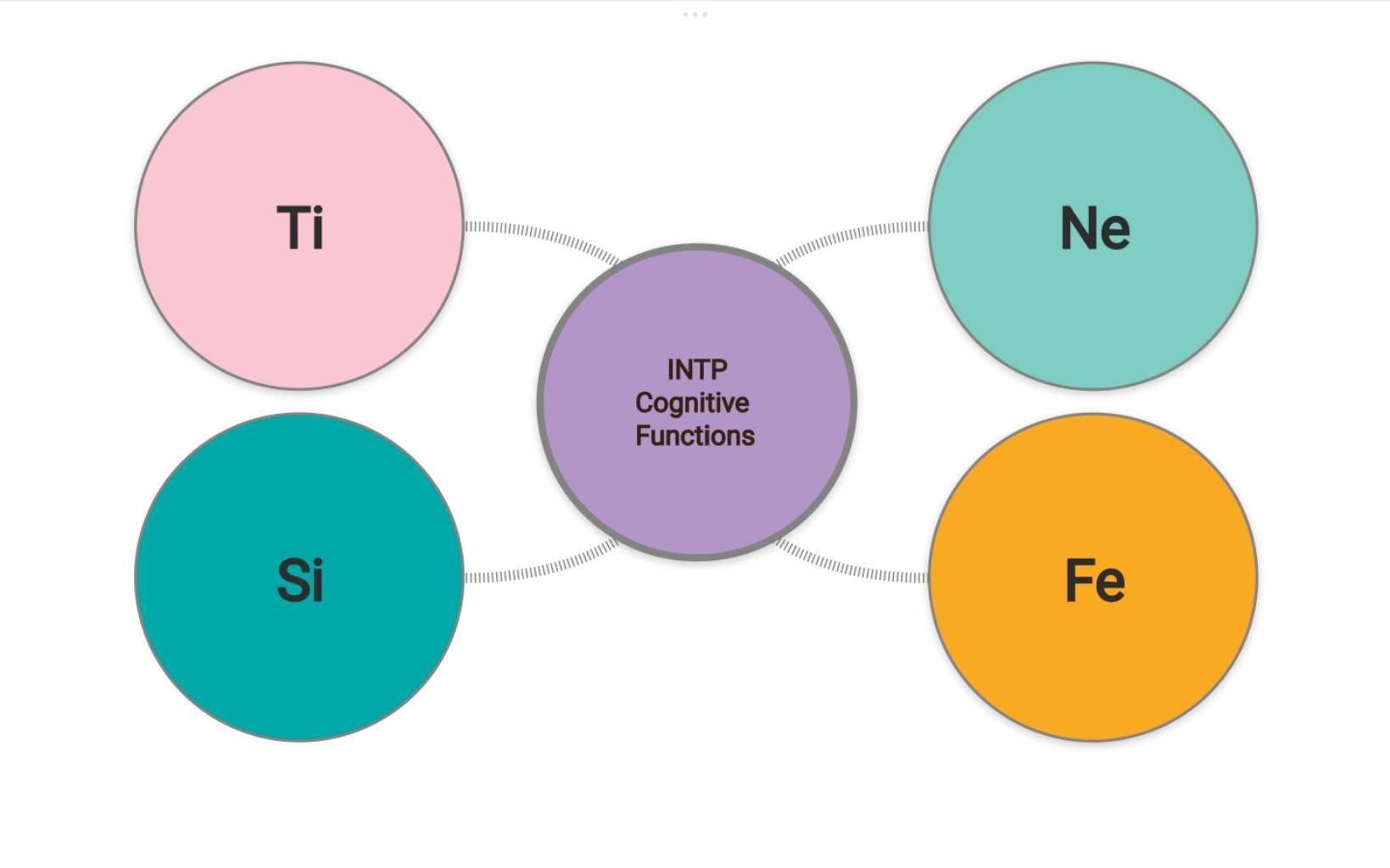
1. Dominant Function: Introverted Thinking (Ti)
First up, we’ve got the captain of the team, Introverted Thinking (Ti). If the INTP’s brain was a courtroom, Ti would be the judge. It’s all about logic, accuracy, and figuring things out. When faced with a problem, Ti doesn’t just scratch the surface—it digs deep to understand every little detail. It’s like having a personal detective in your head who won’t rest until every clue is pieced together.
But, here’s the catch: Ti can get so obsessed with being right that it sometimes forgets about the human side of things. Imagine you’re so focused on solving a puzzle that you don’t realize your friends are waiting for you to hang out. That’s Ti in a nutshell—brilliant, but a bit too wrapped up in its own thoughts sometimes.
2. Auxiliary Function: Extraverted Intuition (Ne)
Next in line is Extraverted Intuition (Ne), the team’s creative genius. Ne is the idea machine, always connecting the dots between things that seem unrelated. Ever notice how INTPs come up with the most random ideas? That’s Ne at work. It’s like having a brainstorming session with yourself all the time—always seeing possibilities and asking “what if?”
Ne keeps things exciting and fresh, but it also has its downsides. With so many ideas bouncing around, it can be hard to stay focused on just one. It’s like trying to catch butterflies with a net—you’re so busy chasing the next one that you forget about the first. So, while Ne brings creativity and innovation to the table, it can also make it tough for INTPs to stick to one path.
3. Tertiary Function: Introverted Sensing (Si)
Moving down the stack, we meet Introverted Sensing (Si), the quiet observer. Si is all about memories, routines, and the little details that make up our past experiences. For INTPs, Si acts like a filing cabinet, storing all those facts and figures they’ve picked up over the years. It helps them remember things they’ve seen or done before, which can be handy when they need to reference something from the past.
However, Si isn’t as flashy as Ti or Ne. It tends to stay in the background, keeping things steady and familiar. While it’s great for recalling details and sticking to routines, it can sometimes make INTPs a bit stuck in their ways. Imagine always ordering the same dish at a restaurant because you know it’s good—that’s Si keeping things predictable.
4. Inferior Function: Extraverted Feeling (Fe)
Last but not least, we’ve got Extraverted Feeling (Fe), the team’s emotional antenna. Fe is all about understanding and managing relationships. It’s the part of the INTP that cares about harmony and how others feel. The thing is, since it’s the weakest function in the stack, Fe doesn’t always get a lot of attention. It’s like having a friend who’s really good at reading the room, but you only listen to them when things start going south.
Fe often shows up when INTPs are in social situations or dealing with emotions—areas where they might feel out of their depth. It can make them a bit awkward, like when you try to join a conversation but aren’t sure what to say. But here’s the bright side: even though Fe is the underdog, it can help INTPs grow by learning to connect with others and show a bit more empathy.
You Might Like To Read: INFP Cognitive Functions (Fi, Ne, Si, Te): 4 Functions Explained in Very Simple Manner
The Shadow Functions
Imagine you’ve got a mirror version of yourself—one that only comes out when you’re stressed, tired, or pushed to your limits. That’s what shadow functions are like for INTPs. They’re the flip side of your usual cognitive team, and while they don’t show up every day, they can make a big impact when they do.
1. Extraverted Thinking (Te) – The Taskmaster
First up in the shadow lineup is Extraverted Thinking (Te). If you’ve ever seen an INTP suddenly get super organized and start barking orders like a drill sergeant, that’s Te making an appearance. It’s all about efficiency, structure, and getting things done—like the polar opposite of your easygoing, let’s-ponder-this-a-little-longer Ti.
But here’s the thing: Te can be a bit rough around the edges for INTPs. It’s like when you try to organize your closet and end up throwing half your stuff on the floor out of frustration. Te might get things done, but it’s not always pretty.
2. Introverted Intuition (Ni) – The Mystic
Next, we’ve got Introverted Intuition (Ni), the shadow function that acts like a fortune teller. Ni tries to predict the future by connecting all the dots in ways that don’t always make sense. It’s like having those “aha!” moments, but they’re kind of fuzzy and you’re not sure where they’re coming from.
For INTPs, Ni is like a strange visitor that occasionally drops by, leaving you with half-baked insights and vague gut feelings. It’s intriguing but not very reliable—like reading a horoscope and thinking, “Well, that could be true… or not.”
3. Extraverted Sensing (Se) – The Daredevil
Then there’s Extraverted Sensing (Se), the shadow that lives for the moment. Se is all about diving headfirst into the here and now, experiencing life through your senses. For INTPs, who usually live in their heads, Se is like suddenly deciding to go skydiving because, why not?
But here’s the kicker: Se can lead INTPs to act impulsively, and that can be a bit chaotic. It’s like being the quiet person at a party who suddenly decides to dance on the table. Fun? Maybe. Regrettable the next day? Quite possibly.
4. Introverted Feeling (Fi) – The Lone Wolf
Last on the shadow list is Introverted Feeling (Fi), the deep well of personal values and emotions. Fi is all about what’s important to you—not what others think, but what truly matters to your soul. For INTPs, this can be a bit confusing since Fi doesn’t always play by the logical rules.
When Fi shows up, you might find yourself getting really passionate about something out of the blue—like deciding you need to save all the turtles, right now. It’s heartfelt but can feel a little out of character, like suddenly discovering you’ve got a secret soft spot.
Development and Maturation of INTP Cognitive Functions
Now that we’ve got a handle on the shadow crew, let’s talk about how an INTP’s main cognitive functions develop over time. Just like people, these functions grow and change as INTPs move through life.
1. Childhood and Adolescence – The Early Days
In the early years, INTPs are all about Introverted Thinking (Ti) and Extraverted Intuition (Ne). It’s like having two best friends who are always up to something—one loves solving puzzles, and the other loves coming up with wild ideas. As kids, INTPs might spend a lot of time tinkering with things, asking “why?” a lot, and dreaming up new possibilities. School can be a mixed bag; they might excel in subjects that challenge their minds but get bored with anything too routine.
2. Adulthood – Hitting Your Stride
As INTPs move into adulthood, Introverted Sensing (Si) starts to come into play. This is when they begin to appreciate the value of a little structure and routine, even if they’d rather not admit it. Si helps INTPs draw on past experiences and build a bit of consistency in their lives. It’s like realizing that, hey, keeping a regular schedule isn’t the worst thing in the world.
At the same time, Extraverted Feeling (Fe) starts to nudge its way in, making INTPs more aware of how their actions impact others. This might show up as an increased effort to be polite or considerate, even if it doesn’t come naturally. INTPs might start caring a bit more about maintaining harmony in their relationships, or at least figuring out how to avoid stepping on toes.
3. Late Adulthood – The Wisdom Years
In the later stages of life, INTPs often start to integrate all their functions in a more balanced way. Si and Fe continue to mature, helping INTPs become more well-rounded and grounded. They might find themselves more in tune with their feelings and better at connecting with others on a deeper level.
And those shadow functions? They might start showing up in more productive ways, helping INTPs push beyond their comfort zones. Te might help them take charge when needed, Ni could offer clearer insights, Se might encourage them to enjoy the moment, and Fi might deepen their sense of purpose.
Practical Applications of Understanding INTP Cognitive Functions
So, why should you care about all these cognitive functions? Well, it turns out they can be pretty useful in helping INTPs navigate life, work, and relationships. Here’s how:
1. Personal Growth and Self-Improvement
Understanding your cognitive functions is like getting a user manual for your brain. Once you know that your dominant function is Introverted Thinking (Ti), you can focus on honing your logical and analytical skills even more. You might decide to dive deeper into subjects that challenge your mind or take up hobbies that require problem-solving, like coding or chess.
But here’s the kicker: knowing your weakest function, Extraverted Feeling (Fe), can help you work on areas where you might struggle. If you’re aware that you’re not naturally great at picking up on social cues, you can make a conscious effort to improve. Think of it like going to the gym for your brain—practicing empathy, being more considerate, and even learning to express your feelings a bit better. It might be uncomfortable at first, but it’s worth the effort.
2. Career and Work Environment
In the workplace, understanding your cognitive functions can guide you toward roles that suit your strengths. INTPs excel in jobs that allow them to think independently, solve complex problems, and explore new ideas. Careers in science, engineering, writing, or technology can be a good fit because they let you use that sharp Ti and creative Ne combo.
But here’s a tip: watch out for jobs that require a lot of repetitive tasks or intense social interaction. These might drain your energy and leave you feeling unfulfilled. On the flip side, if you’re in a role that demands you to work with others or manage teams, knowing that Fe is your weaker function can help you proactively develop those skills. You might not become a social butterfly, but you can learn to navigate the people side of things more smoothly.
3. Relationships and Social Interactions
Now, let’s talk about relationships. INTPs are great at connecting with others on an intellectual level, thanks to that powerful Ti. But when it comes to emotional stuff, things can get a bit tricky. By understanding that Fe is your least developed function, you can approach relationships with more self-awareness.
For example, you might find it challenging to express your feelings or understand why someone’s upset. But instead of feeling frustrated or confused, you can remind yourself that this is just part of your cognitive makeup. You can then make an effort to listen more, ask questions, and show that you care, even if it doesn’t come naturally. Over time, you’ll get better at this, and your relationships will be stronger for it.
Common Misconceptions About INTP Cognitive Functions
Alright, now that we’ve covered the practical stuff, let’s clear up some common misconceptions about INTPs and their cognitive functions. There are a few stereotypes that float around, and they’re not always accurate.
1. Myth: INTPs Are Cold and Unemotional
One of the biggest misconceptions about INTPs is that they’re like robots—cold, unfeeling, and all about logic. Sure, Ti leads the charge with logic, but that doesn’t mean INTPs don’t have feelings. They just express them differently. Think of it like a computer that has emotions running in the background—you might not see them, but they’re there.
When INTPs do show emotion, it’s often through actions rather than words. They might fix something for you or share a fascinating article they think you’ll like. Just because they’re not gushing with emotions doesn’t mean they don’t care—they just have a unique way of showing it.
2. Myth: INTPs Are Lazy or Unmotivated
Another common myth is that INTPs are lazy because they spend a lot of time thinking or daydreaming. The truth is, INTPs are constantly working—just not always in a way that’s visible to others. Their minds are like computers running complex algorithms in the background, solving problems, and generating ideas.
When they’re passionate about something, INTPs can be incredibly focused and productive. The key is finding something that truly interests them. If you see an INTP lounging around, they’re probably deep in thought, not slacking off. It’s like they’re mentally building a rocket ship while you’re wondering why they haven’t taken out the trash yet.
3. Myth: INTPs Are Anti-Social
People often think INTPs don’t like socializing because they’re quiet or prefer alone time. While it’s true that INTPs enjoy their solitude, it doesn’t mean they’re anti-social. They just prefer meaningful conversations over small talk. It’s like being at a buffet—they’d rather have a few gourmet dishes than pile their plate with everything.
When INTPs do engage in social situations, they’re often drawn to deep, intellectual discussions. They’re not the life of the party, but they’re the ones you want to talk to when you want to explore big ideas or learn something new. They might not always be the most outgoing, but they value connections that stimulate their mind.
Conclusion On INTP Cognitive Functions
In a nutshell, INTP Cognitive Functions are the key to understanding the mind of an INTP. They explain why INTPs approach life with logic, creativity, and a dash of quirkiness. Whether you’re an INTP trying to figure yourself out or just someone who wants to understand these brainy types better, knowing about these functions can help you connect the dots. So, next time you’re around an INTP, you’ll know exactly what’s going on under the hood.
If you like the post, then please don’t forget to share with your friends.
Some Of The Previous Posts
